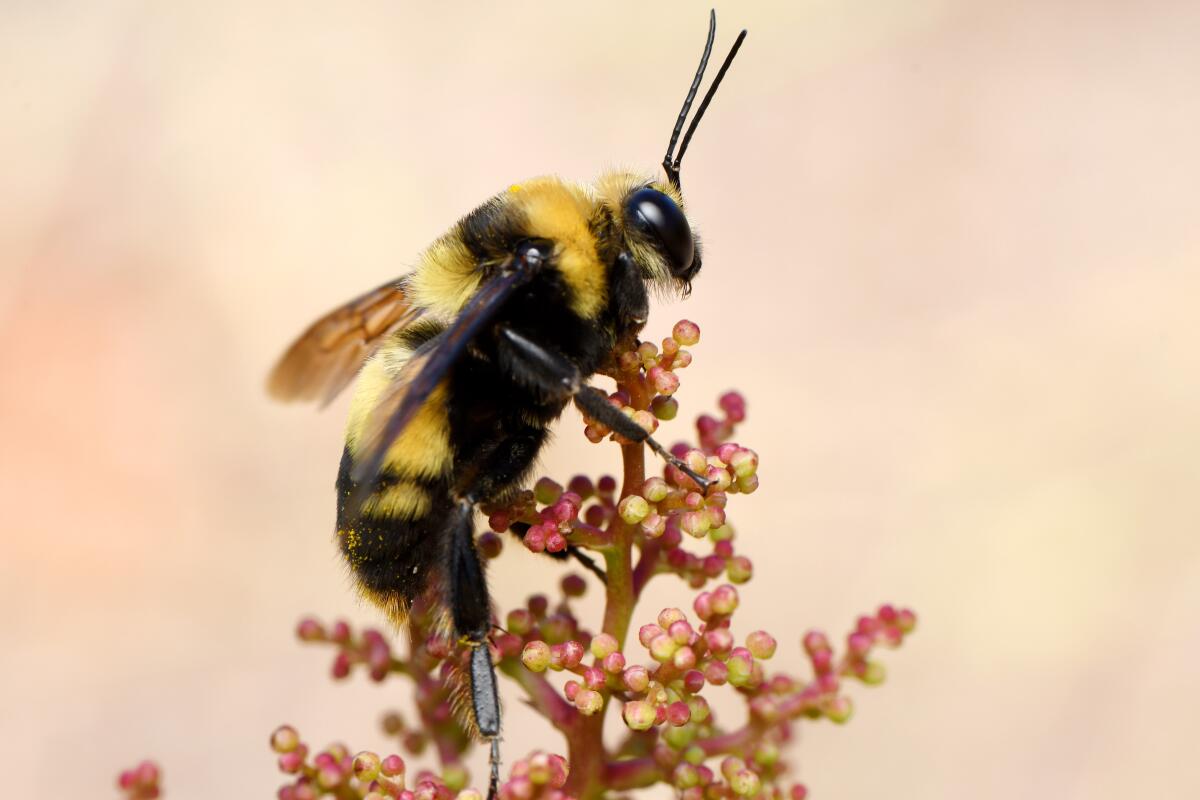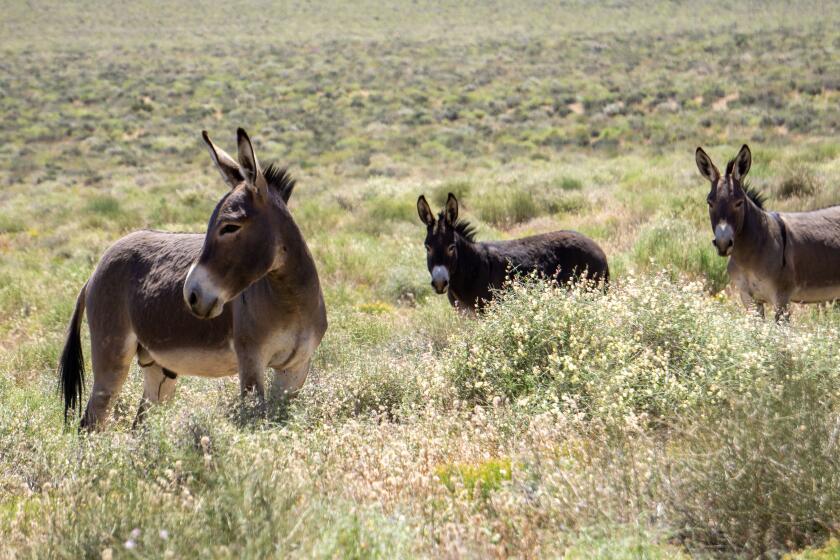Bumblebees can be classified as ‘fish’ under California conservation law, court says

- Share via
JOSHUA TREE, Calif. — In a move that could allow a broad range of insects to be considered for endangered species status, the state Supreme Court has found that California bumblebees can be protected under the law as a type of fish.
The decision, which may carry deep consequences for the state’s agriculture industry, focuses on the arcane wording and complicated legal history of the California Endangered Species Act — a precursor to the federal law.
The court said late Wednesday that it would not hear arguments over whether the California Fish and Game Commission can consider granting protections to a number of bumblebee species whose populations are in steady decline. For the last three years, state almond growers, builders and pesticide companies had been arguing that bumblebees were exempt from listing because the state conservation law does not mention insects.
In writing for the court, however, Chief Justice Tani Cantil-Sakauye said that even though the law does not use the word “insects,” sections of the law suggest that invertebrates may be grouped under the category of fish. She also suggested that the Legislature “is in a position to make whatever statutory amendments it may regard as necessary or useful” to clarify such ambiguities in the endangered species act.
Cantil-Sakauye also warned against misconstruing the decision as “an affirmative determination by this court that under the law, bumblebees are fish.”
A war on urban coyotes is exposing deep divisions between those who want to eradicate the animal and those who are calling for peaceful coexistence.
Wednesday’s decision was quickly hailed by conservation groups.
“We are elated with the California Supreme Court decision,” said Sarina Jepsen, endangered species director with the Xerxes Society for Invertebrate Conservation. “Now, some of California’s most endangered pollinators may be saved from extinction.”
The dispute arose after a coalition of conservation groups led by the Xerces Society, Defenders of Wildlife and the Center for Food Safety in 2018 submitted a petition to protect four species: the western, Franklin’s, Suckley’s cuckoo and Crotch’s bumblebees.
The California Fish and Game Commission voted to begin the listing process, but several agricultural and pesticide industry interests — including the Almond Alliance of California, the California Assn. of Pest Control Advisors and the California Building Industry Assn. — challenged its decision.
They worried that listing the four species would open the door to protections for any of the more than 1,000 species of native bumblebees in California, as well as countless other insects.
The controversy does not involve scientifically cultured honeybees that California’s agricultural communities depend on to pollinate and produce a third of the nation’s vegetables and most of the world’s almonds.
However, the agricultural industry has complained that some of the native bees considered for listing by the commission overlap with important agricultural areas where tilling, planting and harvesting activities could expose farmers and their workers to liability if protected bees are killed.
For example, the California Building Industry Assn., in court documents, suggested that the right to define terrestrial invertebrates as fish could “effectively make a criminal of anyone who has ever swatted a fly, run over an ant or eaten an aphid hidden in their broccoli without a ‘fishing license.’”
More dryness, extreme weather events and water quality hazards are likely in 2023, state water officials said Wednesday.
In Almond Alliance vs. California Fish and Game Commission, the groups complained that the endangered species act explicitly allows the government to designate native species of “bird, mammal, fish, amphibian, reptile or plant,” but excludes invertebrates such as bees.
The commission argued, however, that a separate section of the state fish and game code defines fish to include “wild fish, mollusk, crustacean, invertebrate, or amphibian.”
A Superior Court trial sided with the industry groups.
In 2021, the Stanford Environmental Law Clinic intervened on behalf of the petitioners, who appealed.
In May, the trial court ruling was reversed by a California 3rd District Court of Appeal opinion that found the state Legislature defined the term “fish” as “a wild fish, mollusk, crustacean, invertebrate, amphibian, or part, spawn, or ovum of any of those animals.”
Therefore, the endangered species act’s definition of “fish” is a legal term of art that extends beyond the commonly understood meaning of “fish.”
Whether the highly contested conservation law will ever be reopened for an overhaul by combative stakeholders remains to be seen. First passed in 1970, the California Endangered Species Act was repealed and replaced by an updated version in 1984 and amended in 1997.
California officials say a marsh restoration site provides key fish habitat. Critics say much of the land is too high above sea level to benefit fish.
Word of the court’s decision set the world of native bee aficionados buzzing with rare, encouraging news.
It is a world that seems by its very nature to be pastoral and calm but which is honeycombed with problems, including climate change, competition from cultured honeybees, shrinking habitat and pesticides.
On a recent morning, as she awaited the Supreme Court decision, Krystle Hickman hovered over clumps of buckwheat in the western Mojave Desert, using a camera to document native bees. The insects, some less than a quarter-inch long, drank nectar and gathered cargoes of pollen.
“People tend to think of ecology as being very big, landscape in scale,” the 37-year-old said. “But each one of these bushes exists as a sort of densely populated universe unto itself.”
The photographer and artist has spent the last several years developing identification materials and photo galleries designed to give people a peek into often overlooked natural communities shared by insects including native bees.
“The Supreme Court decision is terrific news for these insects,” Hickman said. “They are worthy of study, admiration and preservation.”
More to Read
Sign up for Essential California
The most important California stories and recommendations in your inbox every morning.
You may occasionally receive promotional content from the Los Angeles Times.














